Sixty Years Hence
Sixty Years Hence by Charles Frederick Henningsen is a notable yet largely undiscovered work in the realm of dystopian science fiction, penned in 1847—a hundred years before Orwell's classic, Nineteen Eighty-Four would bring similar themes to the mainstream. This specific copy, as detailed further below, represents a rare glimpse into the early stages of dystopian fiction, harboring a wealth of history and intrigue within its pages. The following descriptions and notes about this copy were aided by material and certificate of authenticity courteously provided by Lloyd W. Currey, who attests to the rarity and significance of this early work of science fiction.
This presentation copy contains signed inscriptions by "the author" on the front free endpapers of volumes II and III. The inscription in volume I has been cut out. The inscriptions, made in "Jany. 1847", denote the volumes as a gift to "Justina L. Hasenclever from the author". While the identity of the recipient remains unknown, accompanying the book are three seemingly unconnected letters from 1851, written by an Andrew Cooper to a Dr. Pring of Weston Super Mare, which may provide clues.
Volume I has a piece cut out of the front endpaper and below that there is an 1877 clipping from a Stockholm newspaper obituary commemorating Henningsen. Each volume contains a small label on the rear paste-down, adorned with neatly penciled reference notes. This copy was part of George Locke's Spectrum collection.
Beyond the few copies located by Negley, and a copy at Harvard University, there are virtually no known copies in circulation—a true rarity.
Hardcover. First Edition. Octavo, three volumes: pp. [1-2] [i] ii-iv [1] 2-339 [340: blank]; [1-2] [1] 2-350; [1-2] [1] 2-381 [382: blank] [1-6: ads], original decorated brown cloth, spine panels stamped in gold and blind, front and rear panels stamped in blind, all edges untrimmed, yellow coated endpapers. [LWC]. London: Thomas Cautley Newby Publisher, 72, Mortimer St., Cavendish Sq. 1847. #11147.
Each volume has lean to spine, along with minor scuffs and spotting to the cloth. The text blocks are slightly toned, dusty and marked, with some dog-eared corners, cracking at points and some gatherings working loose. Very good overall.

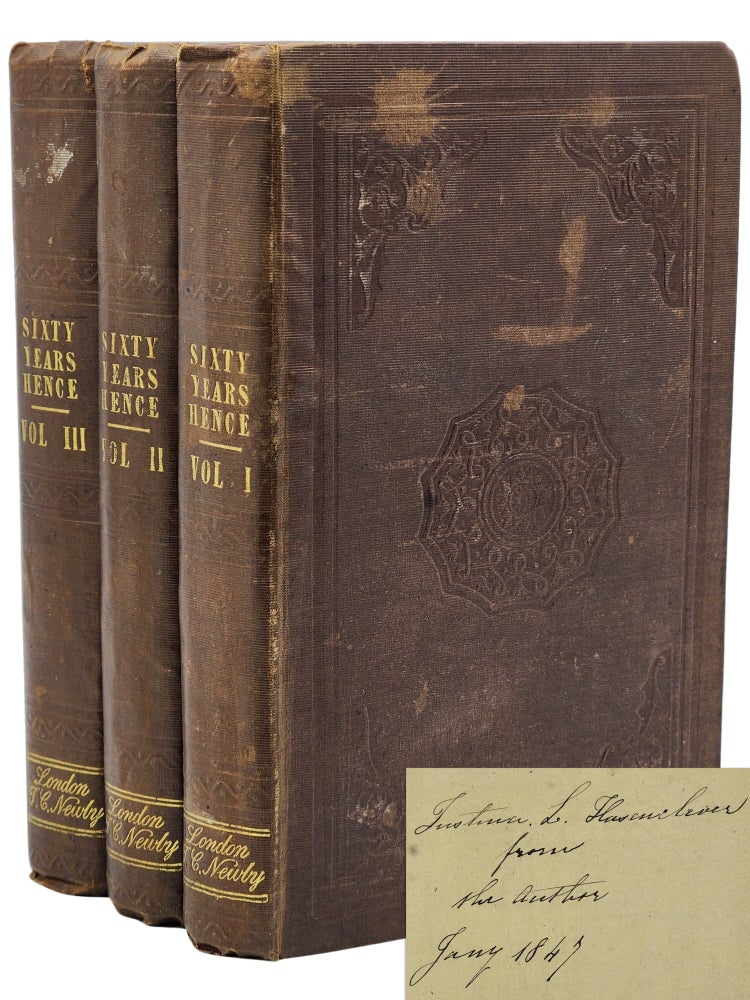
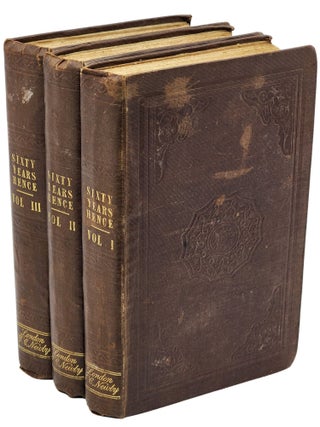
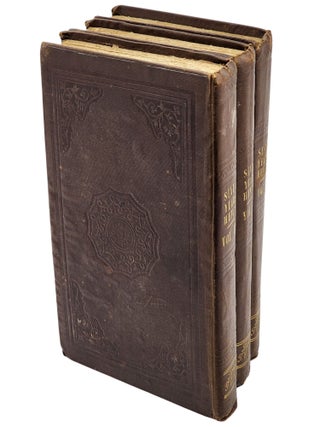
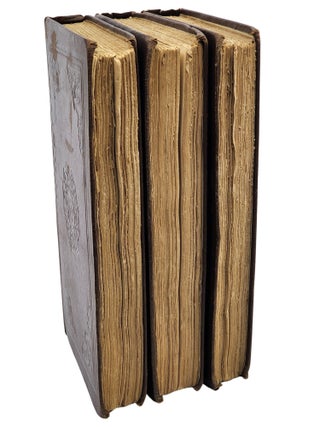
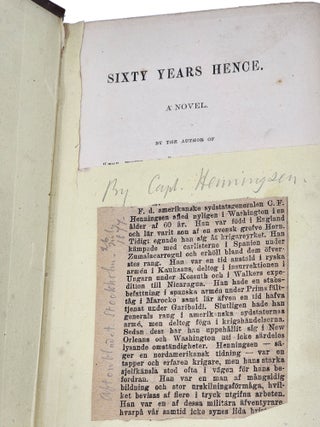
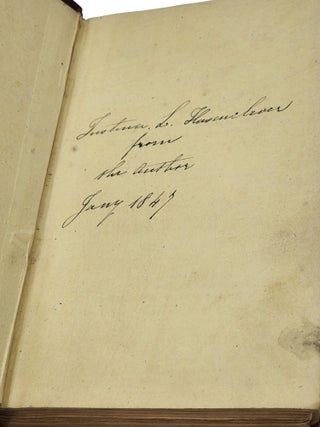
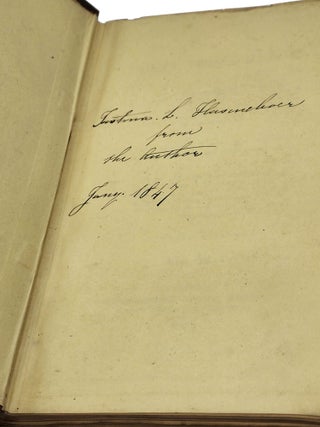
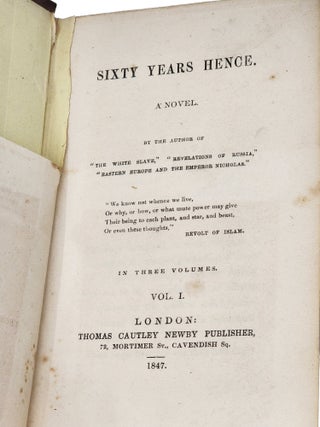
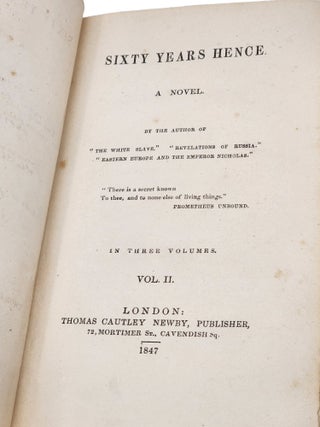
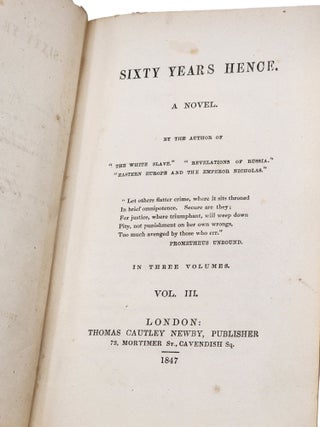
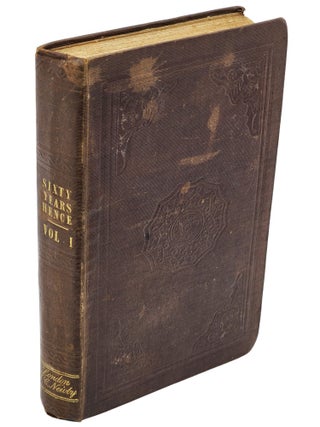
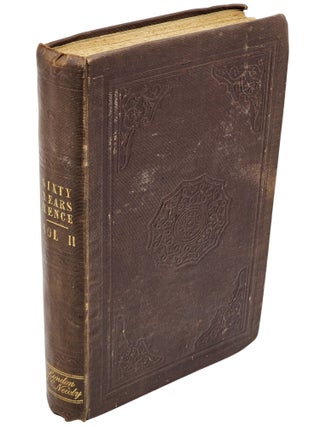
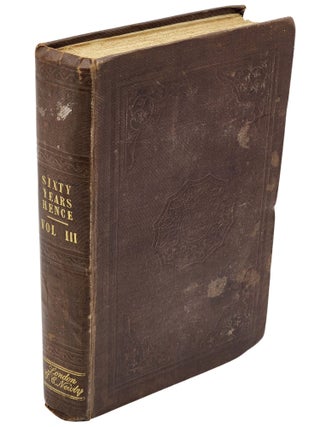
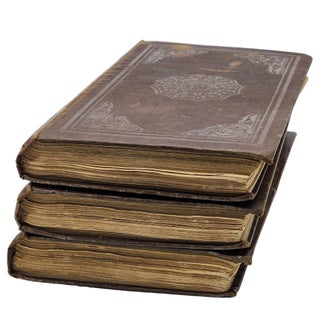
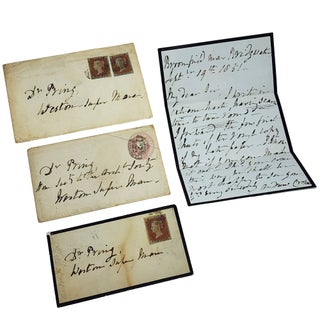
In the vast landscape of literature, there are always works that, significant yet, remain largely undiscovered and unexplored. Charles Frederick Henningsen's Sixty Years Hence, published in 1847, stands as a testament to this, emerging as a fascinating and early contribution to the realm of dystopian fiction.
As the title dictates, the novel is set in the future, and while there are hints of technological advancements in the foreboding years 1905-1907, the narrative is chiefly a political satire and blistering critique of the laissez-faire capitalist agenda of the incumbent Whig government of Henningsen's time. Henningsen, a passionate Chartist, a member of the mass working-class reformist movement in the 19th century, channels his deep-seated political convictions, inspired in large part by the catastrophic famine in Ireland.
At the center of the plot is a terrifying disease that affects all farinaceous foods worldwide, including staple crops like potatoes. Despite mankind's relentless scientific interventions, the disease only mutates further, posing an ever-growing threat to the global food supply. This narrative thread appears to underline Henningsen's grave concerns about the potential pitfalls of unrestrained scientific progression.
In a nightmarish extrapolation of the Whig ideology taken to its extremes, the story paints a grim picture of a world succumbing to communist dogmas. Not unlike George Orwell in his own dystopian masterpiece written a century later, Henningsen envisions a world divided into three powerful states, each united not by language or history, but rather by distinct political ideologies. These include the Federative Monarchies, the Bokarian Despotism, and the Democratic Union, with the latter fostering "wild communistic doctrines" such as "the rights of Labour".
The action primarily unfolds in the Federative Monarchies, a realm controlled by the immensely wealthy "Senatorial order of MILLIONAIRES". These affluent rulers, denoted with titles emphasizing their vast wealth, find themselves grappling with internal dissidents who harbor sympathies for the foreign Democratic Union. However, as Volume III unfolds, the stability of society crumbles, where battles over diseased corn trigger widespread chaos and starvation. At the helm of this disintegrating world are rulers John Cash and Invective Rabid, who face mounting troubles and an impending catastrophe.
Meanwhile, a man named Tempest, confined to an insane asylum as a lunatic, might hold the key to defeating an insect plague threatening to destroy all organic life. This apocalyptic event, a result of evolutionary mutations over centuries, is just moments away from unleashing its fury. Tempest's warnings fall on deaf ears, as ruler Cash opts for a path that ensures his wealth, even at the expense of humanity's survival.
Yet, Sixty Years Hence isn't solely a tale of doom and gloom. Henningsen, who himself led a thrilling life as a soldier of fortune, infuses his narrative with generous doses of sex, romance, and drama. In a nod to Henningsen's expertise in munitions and artillery, Tempest not only holds the scientific secret necessary to defeat the insect, but he also invents a special liquid that neutralizes enemy weapons, a crucial element in securing victory against a defenseless army.
Undoubtedly influenced by the writings of the English author Edward Bulwer-Lytton, this remarkable work serves as a potent warning against political extremism and the dangers of unbridled scientific advancements.
References: Lloyd W. Currey. Clarke, Tale of the Future (1978), p. 4 (apparently not seen by Clarke who probably would have thought highly of this work had he encountered it). Locke, A Spectrum of Fantasy, Volume II, p. 60 (long, enthusiastic write-up). Negley, Utopian Literature 552 (locating only the Bodleian and Library of Congress copies). Sargent, British and American Utopian Literature, 1516-1985, p. 49.